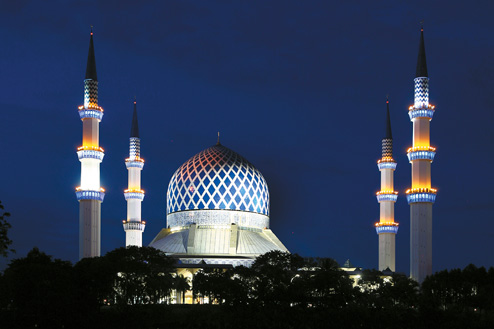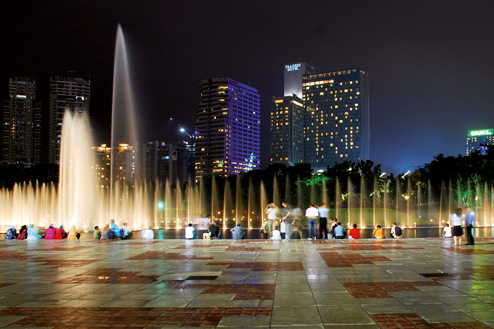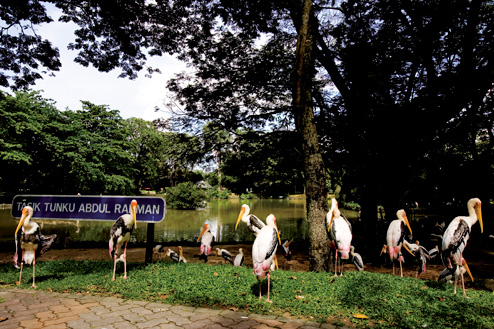Chinatown
Chinatowns the world over have their own magical qualities, and the one in Kuala Lumpur does not disappoint. It’s difficult not to be excited by the variety of exotic aromas, the bustle of traders, the sense of excitement and the theatre of it all. While it can get hot, busy and sometimes claustrophobic, at least you know you are alive when you are in this part of KL.
Chinatown doesn’t actually exist on most KL street directories. It is often referred to as Jalan Petaling (Petaling Street), which is the best known street and taxi drivers may better understand this as a direction rather than Chinatown. The area is concentrated around Petaling Street and bounded by Jalans Tun HS Lee, Cheng Lock, Hang Lekir and Balai Polis.
Once in the district, walking is the best way to get around and to connect with other places like Central Market. Much of what occurs in this part of town has not changed for decades. You may still see old men pedalling their bicycles, collecting and delivering their wares as they always have for decades. Chinese medicine shops display their various traditional herbs and medicines. There are goldsmiths, basket weavers, dry goods stores, stores selling pots and pans, food outlets and clothes stores. The old residents hold fast as new developments slowly make inroads and it is obvious that the architectural qualities of the shop facades are changing.
There is always something open, no matter what the time, although the wet market running between Petaling Street and Lorong Bandar is most active early in the morning and at sunset. Every conceivable Chinese product is sold here, from fresh fish and meat to dry herbs and spices. Chinese is the most common language spoken, and this is a place to do business and to sell things – not for asking too many questions and having people pose for photos. For many Chinese, being photographed is a very sensitive issue so indicate or ask before blinding a trader with your flash. Various hawker stalls are located in and around the produce with some hawkers having sold the same thing here for eons.
In the morning, dim sum restaurants are popular for breakfast, but then things quieten down. The streets pick up at lunchtime as office workers descend for lunch. The activity quietens down a little in the afternoon, but once work finishes the streets return to their frenzied state of excitement. Food is served around the clock, in makeshift open-air stalls, in fan-cooled coffee shops, or air-conditioned restaurants. Some favourite dishes in Chinatown include dim sum, Hainanese chicken rice, curry laksa, won ton mee, Assam laksa and yong tau foo. The Old China Café on Jalan Bali Polis is one of the more atmospheric restaurants in KL. It is located in what was once the Selangor and Federal Territory Laundry Association and old historic photos line the walls.
In the evening, restaurants spread out onto Jalan Hang Lekir and there is relaxed, open-air ambience. Several restaurants all sell similar Chinese dishes, but at a premium for foreigners. If you don’t want to pay the higher price, eat in the adjoining restaurant, off the street with the locals where the prices are cheaper.
For many, Chinatown is a big ‘rip-off’ as a variety of inexpensive but fake clothes, watches and DVDs are sold everywhere despite it being illegal. Shopping should be treated as fun and ruthless – bargaining is essential to secure a good deal. The five-foot walkways still remain to offer shelter from the tropical heat, but mostly they are filled with traders and their stalls selling all sorts of treasures.
Many of these merchants sell a variety of near ‘genuine’ brands and seemingly operate with immunity. It’s all a bit of fun, so don’t be surprised if that ‘designer’ watch you buy self destructs just months after being purchased (in fact, many of them are excellent watches but you can guarantee the ‘diamonds’ in the face won’t be real).
While prices may be displayed, bargaining is an essential component of shopping in Chinatown. Firstly, choose a price that you are happy with and then start the game of haggling. You can be assured that the trader will always get the better of you, but does it really matter? Pay what you think it is worth, and enjoy the banter.
While the area is known as Chinatown, it is an ethnically mixed area with an Indian temple and Malay curry houses among the predominantly Chinese shops.
There are several places of worship in the district that make a peaceful retreat from the streetside mayhem. The colourful and ornate facade of Sri Maha Mariamman Hindu Temple built in 1873 is an arresting sight. It was constructed over a century ago and remains important for Hindus.
Malaysia is home to many fascinating festivals, with none more colourful than the Hindu festival of Thaipusam. It is celebrated with the full moon in the tenth month of the Hindu calendar at the end of January or the start of February. The festival proper is celebrated at Batu Caves on the north-western outskirts of the capital; they start in Chinatown. The actual day of the celebrations at Batu Caves is a public holiday for KL residents. However, for Hindus who celebrate, it is three days of festivities that start at the Sri Maha Mariamman Temple in Chinatown and finishes at Batu Caves. The procession to Batu Caves commences as the chariot is pulled by two bulls for the eight-hour journey to the caves. Despite the crowds, congestion and apparent mayhem, this festival is something all residents should experience at least once.
The temple, situated along Chinatown’s Jalan Tun S Lee, is well worth visiting. It is KL’s principle Hindu temple and like most similar temples, it offers a rainbow of colours and a cast of gods and deities that looks totally confusing to outsiders.
Just down the road is the Persatuan Kwong Siew Chinese Temple, built in 1888 by the Kwong Siew Association. Nearby in Jalan Hang Kasturi, Tze Ya Temple is the oldest in Kuala Lumpur. It stands hidden a little back from the street, but look for the colourful facade above the driveway entrance. This small temple is a hive of activity as devotees burn incense, make offerings on the altars and hit big brass gongs to seek help and guidance. Just behind the temple is the large and colourfully decorated Central Market.
One of the least active times in Chinatown is during Chinese New Year. Although there are only two days of official public holidays, most Chinese businesses close for up to five. Before and during the celebration, Chinatown becomes decorated with all things red (the colour the Chinese associate with happiness). Red lanterns light the streets and boxes of imported mandarins are sold. Chinatown is best visited before the celebration – it tends to be quiet during the festivities as Chinese merchants close shop to celebrate with their families. Preparations begin weeks before the actual date, when people start buying presents, food and clothing, and decorating their homes and shops.
There are various transport nodes, with Pudu Bus Station (for long distance buses and taxis) and Pasar Seni Station on the Putra LRT. The KL Hop-On Hop-Off bus also stops in Chinatown and Central Market.
Chinatown doesn’t actually exist on most KL street directories. It is often referred to as Jalan Petaling (Petaling Street), which is the best known street and taxi drivers may better understand this as a direction rather than Chinatown. The area is concentrated around Petaling Street and bounded by Jalans Tun HS Lee, Cheng Lock, Hang Lekir and Balai Polis.
Once in the district, walking is the best way to get around and to connect with other places like Central Market. Much of what occurs in this part of town has not changed for decades. You may still see old men pedalling their bicycles, collecting and delivering their wares as they always have for decades. Chinese medicine shops display their various traditional herbs and medicines. There are goldsmiths, basket weavers, dry goods stores, stores selling pots and pans, food outlets and clothes stores. The old residents hold fast as new developments slowly make inroads and it is obvious that the architectural qualities of the shop facades are changing.
There is always something open, no matter what the time, although the wet market running between Petaling Street and Lorong Bandar is most active early in the morning and at sunset. Every conceivable Chinese product is sold here, from fresh fish and meat to dry herbs and spices. Chinese is the most common language spoken, and this is a place to do business and to sell things – not for asking too many questions and having people pose for photos. For many Chinese, being photographed is a very sensitive issue so indicate or ask before blinding a trader with your flash. Various hawker stalls are located in and around the produce with some hawkers having sold the same thing here for eons.
In the morning, dim sum restaurants are popular for breakfast, but then things quieten down. The streets pick up at lunchtime as office workers descend for lunch. The activity quietens down a little in the afternoon, but once work finishes the streets return to their frenzied state of excitement. Food is served around the clock, in makeshift open-air stalls, in fan-cooled coffee shops, or air-conditioned restaurants. Some favourite dishes in Chinatown include dim sum, Hainanese chicken rice, curry laksa, won ton mee, Assam laksa and yong tau foo. The Old China Café on Jalan Bali Polis is one of the more atmospheric restaurants in KL. It is located in what was once the Selangor and Federal Territory Laundry Association and old historic photos line the walls.
In the evening, restaurants spread out onto Jalan Hang Lekir and there is relaxed, open-air ambience. Several restaurants all sell similar Chinese dishes, but at a premium for foreigners. If you don’t want to pay the higher price, eat in the adjoining restaurant, off the street with the locals where the prices are cheaper.
For many, Chinatown is a big ‘rip-off’ as a variety of inexpensive but fake clothes, watches and DVDs are sold everywhere despite it being illegal. Shopping should be treated as fun and ruthless – bargaining is essential to secure a good deal. The five-foot walkways still remain to offer shelter from the tropical heat, but mostly they are filled with traders and their stalls selling all sorts of treasures.
Many of these merchants sell a variety of near ‘genuine’ brands and seemingly operate with immunity. It’s all a bit of fun, so don’t be surprised if that ‘designer’ watch you buy self destructs just months after being purchased (in fact, many of them are excellent watches but you can guarantee the ‘diamonds’ in the face won’t be real).
While prices may be displayed, bargaining is an essential component of shopping in Chinatown. Firstly, choose a price that you are happy with and then start the game of haggling. You can be assured that the trader will always get the better of you, but does it really matter? Pay what you think it is worth, and enjoy the banter.
While the area is known as Chinatown, it is an ethnically mixed area with an Indian temple and Malay curry houses among the predominantly Chinese shops.
There are several places of worship in the district that make a peaceful retreat from the streetside mayhem. The colourful and ornate facade of Sri Maha Mariamman Hindu Temple built in 1873 is an arresting sight. It was constructed over a century ago and remains important for Hindus.
Malaysia is home to many fascinating festivals, with none more colourful than the Hindu festival of Thaipusam. It is celebrated with the full moon in the tenth month of the Hindu calendar at the end of January or the start of February. The festival proper is celebrated at Batu Caves on the north-western outskirts of the capital; they start in Chinatown. The actual day of the celebrations at Batu Caves is a public holiday for KL residents. However, for Hindus who celebrate, it is three days of festivities that start at the Sri Maha Mariamman Temple in Chinatown and finishes at Batu Caves. The procession to Batu Caves commences as the chariot is pulled by two bulls for the eight-hour journey to the caves. Despite the crowds, congestion and apparent mayhem, this festival is something all residents should experience at least once.
The temple, situated along Chinatown’s Jalan Tun S Lee, is well worth visiting. It is KL’s principle Hindu temple and like most similar temples, it offers a rainbow of colours and a cast of gods and deities that looks totally confusing to outsiders.
Just down the road is the Persatuan Kwong Siew Chinese Temple, built in 1888 by the Kwong Siew Association. Nearby in Jalan Hang Kasturi, Tze Ya Temple is the oldest in Kuala Lumpur. It stands hidden a little back from the street, but look for the colourful facade above the driveway entrance. This small temple is a hive of activity as devotees burn incense, make offerings on the altars and hit big brass gongs to seek help and guidance. Just behind the temple is the large and colourfully decorated Central Market.
One of the least active times in Chinatown is during Chinese New Year. Although there are only two days of official public holidays, most Chinese businesses close for up to five. Before and during the celebration, Chinatown becomes decorated with all things red (the colour the Chinese associate with happiness). Red lanterns light the streets and boxes of imported mandarins are sold. Chinatown is best visited before the celebration – it tends to be quiet during the festivities as Chinese merchants close shop to celebrate with their families. Preparations begin weeks before the actual date, when people start buying presents, food and clothing, and decorating their homes and shops.
There are various transport nodes, with Pudu Bus Station (for long distance buses and taxis) and Pasar Seni Station on the Putra LRT. The KL Hop-On Hop-Off bus also stops in Chinatown and Central Market.













